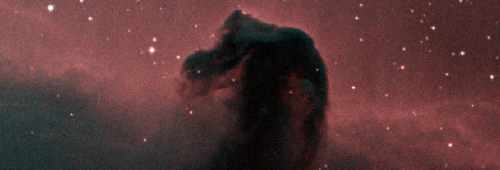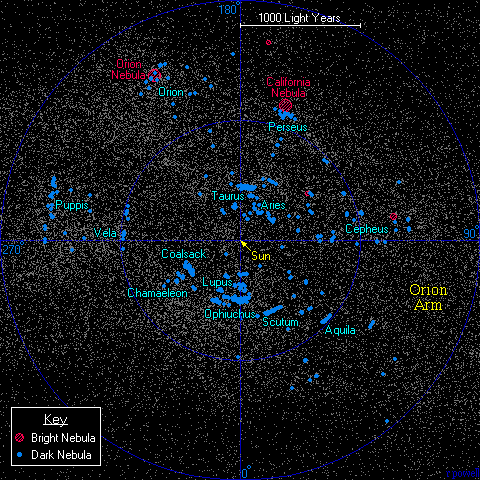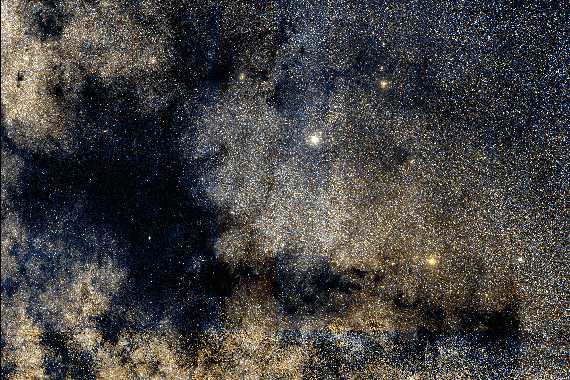
Sometimes known as absorption nebulae these are dark concentrations of gas and dust which often have stars forming inside them. Dark nebulae can be seen if they obscure part of a bright nebula (eg. the Horsehead nebula) or if they block out background stars (eg. the Coalsack).

Here is a map showing many of the dark nebula regions within 2000 light years plotted onto the galactic plane. The map shows the positions of 742 dark nebulae listed by Dutra and Bica. A few bright nebulae are also marked. These dark nebulae are the important regions of star formation in our local part of the Orion Arm. For example, the famous Pleiades star cluster consists of hot young stars that formed among the dark clouds of Taurus.

|
Major Dark Nebula Regions
-----------------------------
Name Equatorial Galactic Distance
Coordinates Coordinates (ly)
RA Dec l° b°
Aries 03 00 +19.5 160 -34 330
Perseus 03 52 +33.2 161 -16 1150
Taurus 04 37 +27.7 172 -13 460
Orion 05 52 +02.3 204 -12 1500
Puppis 07 39 -44.9 258 -11 1500
Puppis 08 21 -36.6 255 0 1400
Vela 08 27 -50.4 267 -7 1000
Coalsack 12 25 -63.7 300 -1 520
Musca 12 28 -70.8 301 -8 490
Chamaeleon 12 34 -77.8 302 -15 590
Lupus 15 45 -34.5 339 +16 460
Lupus 16 01 -39.7 338 +10 470
Ophiuchus 16 31 -22.9 355 +17 520
Ophiuchus 16 50 -14.2 5 +19 520
Scorpius 17 11 -39.8 347 0 490
Ophiuchus 17 22 -24.3 1 +7 520
Scutum 18 33 -06.6 25 +1 650
Corona Austr. 19 14 -36.7 1 -20 520
Aquila 19 19 +11.1 46 -1 1000
Vulpecula 19 22 +23.2 57 +4 650
Cepheus 20 42 +58.6 95 +10 1400
Cepheus 20 56 +67.2 103 +14 1000
|
This diagram below shows where the major molecular clouds can be found along the plane of the Milky Way:

Below is a list of the most famous dark nebulae. These are all supposed to be easily visible with a small telescope, although I have no idea if they are or not. :)
1 2 3 4 5 6 7 8 9
Barnard Common Equatorial Galactic Size Distance Con
Number Name Coordinates Coordinates arcmins (ly)
RA Dec l° b°
B33 Horsehead 05 40.9 -02 28 207.0 -16.8 6'x4' 1400 Ori
- Coalsack 12 53.0 -63 00 303.1 -0.1 400'x300' 500 Cru
B42 Rho Ophiuchi 16 25.5 -23 26 353.7 +17.7 30'x30' 500 Oph
B65/6/7 Pipe (stem) 17 20.0 -26 54 358.6 +5.9 300'x60' 500 Oph
B72 Snake 17 23.6 -23 37 1.8 +7.0 30'x30' 600 Oph
B78 Pipe (bowl) 17 32.7 -25 36 1.3 +4.2 200'x140' 500 Oph
B86 Ink Spot 18 03.0 -27 52 2.9 -2.8 5'x3' ? Sgr
B87 Parrot's Head 18 04.2 -32 30 358.9 -5.2 12'x12' 1000 Sgr
B92 18 15.6 -18 14 12.7 -0.6 15'x15' 650 Sgr
B133 19 06.2 -06 54 28.5 -6.4 10'x5' 1000 Aql
B143 19 41.4 +11 00 48.5 -5.9 30'x30' ? Aql
B348/9 Northern Coalsack 20 34.4 +42 06 81.0 +1.1 240'x240' ? Cyg
B352 20 57.2 +45 54 86.5 +0.3 15'x3' 1900 Cyg
B168 21 53.4 +47 16 94.4 -5.5 100'x10' ? Cyg
|
Column 1: The Barnard classification number of the dark nebula.
Column 2: The common name of the dark nebula.
Column 3: Right Ascension in hours and minutes for epoch 2000.
Column 4: Declination in degrees and minutes for epoch 2000.
Column 5: Galactic longitude of the nebula.
Column 6: Galactic latitude of the nebula.
Column 7: Angular size of the dark nebula in arcminutes.
Column 8: Distance to the dark nebula in light years (very approximate).
Column 9: Constellation in which the dark nebula lies.
References:
Barnard E, (1927), A photographic Atlas of selected regions of the Milky Way,
Carnegie Inst. Washington.
Hilton J, Lahulla J, (1995), Distance measurements of Lynds galactic dark
nebulae, Astron Astrophys Supp, 113, 325.
Dutra C, Bica E, (2002), A catalogue of dust clouds in the Galaxy, Astron
Astrophys, 383, 631.
